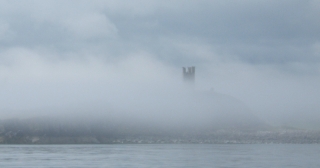Before setting off sailing we did consider that during our trip we might provide useful insight into the state of Britain during a period of recession, social comment on how the country is faring based on observation made as we moved around the coast of Britain. However the tell-tale signs of hardship that we thought might be obvious have proved less easy to spot in the places we have visited, or at least less easy to attribute to the country's current financial condition. For example, one observation that has struck us is that our own boat has become larger as we have moved north. To spot this it is necessary to be outside the vessel and in the proximity of other boats. It takes a few minutes to realise that this is merely a relative phenomenon and that it is the boats around us that have diminished in size. In the Southeast and all along the south coast a sailing boat must now be at least 40 feet long to be remotely seaworthy, so it seems, whereas in Amble our catamaran's 31 feet length overall dwarfs most other boats in the marina. Of course this is merely a sign of the north/south divide - hasn't it always been so.
Then again we wondered weather the seas would now be empty of luxuries like yachts, whether tourism would be at a complete standstill, enjoyment on hold. Until the last few days this did look likely but we now realise that it was simply too early in the year for most people to be sailing.
Now we are in a holiday week and there are enough people to fill the trip boats out to the Farne Islands, many times over, so like any other year the terns have plenty of human heads to attack on the path up from the landing - a hat is a compulsory item.
Selective layers of mist meant that we saw the tourists at Dunstanburgh before we saw the castle itself and even when it did appear it was just a ruined turret hovering in the cloud. We had almost sailed on by before the full size of this spectacular seaside extravaganza revealed itself.
So it seems there is no shortage of tourists after all and of course no shortage of castles for them to visit here either. In fact castles are so thick on the ground in this part of Britain that it is difficult to take a picture without capturing one.
Although Holy Island has a perfectly good castle of its own, just across the way Bamburgh creeps into shot, two for the price of one, so to speak. But somehow Lindisfarne tops all the charts for total pointlessness as well as for sheer arrogance and I can well understand the attraction this place holds. What better use for an isolated lump of rock on a remote island at the edge of Britain than to build a castle on it - the tourists will always flock here to see it.
They even chance the tidal causeway that connects mainland to the island. Most will make it back safely but every year the tide catches a few out and pubs on the island showcase pictures of the rescues of those who don't, 4 x 4s with water lapping the tops of the doors with sad, scared figures sitting atop.
There is a time, of course, when the tide returns and this place becomes silent, no one left but the residents and just the one boat crew, ours.





No comments:
Post a Comment